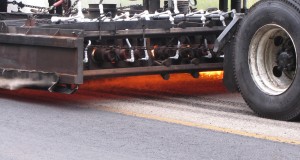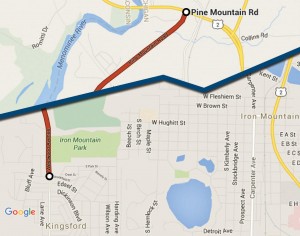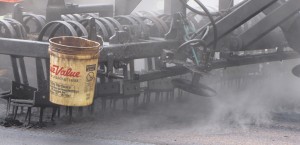The Bridge, Vol. 29, No. 4, Spring 2016
Stephanie Hubble, Technical Writing Intern
A pre-heater roars over the cracks beginning to spider web across the lane from years of traffic; a second pre-heater rumbles over the softening asphalt before tines scarify the now crumbling road. Rejuvenating oil is added, mixed with the old asphalt, and re-compacted. This process, with minor variations depending on the project, is hot in-place recycling (HIPR).
HIPR is “the process of correcting asphalt-pavement surface distress by softening the existing surface with heat, [either scarifying or] mechanically removing the pavement surface, mixing it with an asphalt binder, and replacing the recycled material on the pavement without removing it from the original pavement site.” What made HIPR the best technology for one Michigan road?
According to Lance Malburg, Dickinson County Road Commission (CRC) Engineer, “HIPR is a valuable, but little used tool in the road preservation toolbox.” Malburg understood that HIPR has a time and place. “You have to look at the road. You don’t want something that’s completely failed. Cracked, yes, but not all patches.” Pine Mountain Road-Westwood Avenue, located in Kingsford, Michigan, and Breitung Township, had a PASER of 3 or 4 with some patches of PASER 2 and a fairly consistent asphalt depth.
Malburg first learned of HIPR in the mid 1990s while working for the City of West Chicago (Illinois). At this time, HIPR was still proving its worth, but the principle behind the process fascinated Malburg. As Malburg’s career took him to other local agencies, he kept looking for ways to use HIPR on a project and to try new HIPR innovations. Then, in February 2014, Malburg learned about a way to fund a project with HIPR through an Accelerated Innovation Deployment (AID) Demonstration grant.
AID Demonstration grants stem from a branch of the Technology and Innovation Deployment Program (TIDP), an FHWA program made possible by MAP-21. This grant covers a percentage of the project up to the full cost, as long as the total is less than $1,000,000 and is open to any project that is eligible for assistance under Title 23 U.S.C. Of course, projects that use Every Day Counts (EDC) initiatives are encouraged as well as other aspects of highway transportation addressed by the TIDP.
Because of the focus on innovation and development, Malburg wanted to be sure that the results of any project done with AID funds would be visible to the public. This made the Pine Mountain Road-Westwood Avenue project a perfect candidate, both because Pine Mountain Road-Westwood Avenue hadn’t completely failed and because Dickinson CRC feared it wouldn’t have the necessary funding to repair the road before it completely failed.
“The application for an AID grant isn’t difficult. Most everything has templates, even the narrative where you describe your project,” Malburg stated. However, local agencies are not able to apply for AID grants directly; requests have to go through a state department of transportation. Local agencies are only able to apply through state DOTs as sub-recipients. This means MDOT has people—like MDOT Engineer of Operation Field Service Division, Mark Geib, who was able to help Malburg—ready to help local agencies and pass on grant applications to FHWA.
Pine Mountain Road: red road in top of map; Westwood Avenue: red road in bottom of map.
The project covered 4.2 miles of road between the points illustrated on the maps (right)
in the city of Kingsford and Breitung Township (Dickinson County), Michigan (Map data 2016 Google).
“The FHWA staff was a big help,” Malburg said. After the application was submitted, FHWA called Malburg and asked if Dickinson CRC would try something a little bit different. Regarding the change, Malburg said, “They asked about whether the project needed the 1-inch hot-mix asphalt (HMA) top course we proposed and I explained our research in HIPR shows only slight improvement in the ride. FHWA staff said a 3/4-inch ultrathin warm-mix asphalt (WMA) would work and qualify for additional funding under AID grant requirements.” The WMA overlay gave Pine Mountain Road-Westwood Avenue a smoother finish as well as several other benefits.
WMA is an EDC initiative that can reduce project costs and keep production temperatures lower than more common HMA methods. In fact, many WMA technologies are already used to improve asphalt binder viscosity and density. The only difference between HMA and WMA is the introduction of a foaming agent—water or other chemical—into the HMA process. This agent can help contractors reduce heat, but Michigan WMA specifications do not require any specific reduction in temperature. The contractor for the Pine Mountain Road-Westwood Avenue project reported that WMA saved 0.1 to 0.2 gallons of heating oil per ton, which may not seem like much, but ended up saving 500 gallons of oil.
With a traditional repairs of this extent, lane closures are usually anywhere between 5 to 8 days for every mile of construction. With Dickinson CRC’s HIPR and WMA overlay lane closures were 3.3 days per mile. This meant, instead of nearly 30 days of construction, the Pine Mountain Road-Westwood Avenue project only saw lane closures for 14 days spread over the 4.2 miles of the project.
Tines scarifying the Pine Mountain Road (Photo credit: John Kiefer)
Traditional repaving methods used by Dickinson CRC also cost more than this HIPR project, even with the need for an overlay. For the Pine Mountain Road-Westwood Avenue project, HIPR with a WMA overlay cost approximately $189,000 per mile versus an estimated $380,000 per mile with a traditional crush, shape, and pave project. The total project cost was $790,000—$760,227.69 for construction and $30,000 for engineering, documentation, and testing. Overall, this added up to a savings of over 40% for the Pine Mountain Road-Westwood Avenue project.
Before Malburg could have a successful project, he needed to gain community support. Support was gained through technology transfer, or how new technology is passed between inventors, scientists, and engineers—like Malburg—to end users—like the people using Pine Mountain Road and Westwood Avenue every day. Not only is technology transfer an integral part of the AID grant process3, but technology transfer keeps the public informed of innovations that help the community. He was able to facilitate technology transfer through town hall meetings, articles in local papers, and project showcases. “Surprisingly, I had little trouble getting local approval for the Pine Mountain Road-Westwood Avenue project,” Malburg states. This answer most likely had something to do with the lengths taken to inform the community about the innovations used on this project.
Even though the asphalt has cooled, it doesn’t mean this project is over. One of the most important parts of trying something new is seeing how it lasts. Malburg and the Dickinson CRC will continue monitoring Pine Mountain Road-Westwood Avenue each year, using photos to see how it handles stress, and compare the results with similar roads using traditional treatments.
“I’m proud that our project is on the cutting edge and in the Upper Peninsula of Michigan,” said Malburg. Initiatives like Malburg’s show that counties, cities, and local agencies can come together to apply innovative roadway technologies throughout our pleasant peninsulas.








